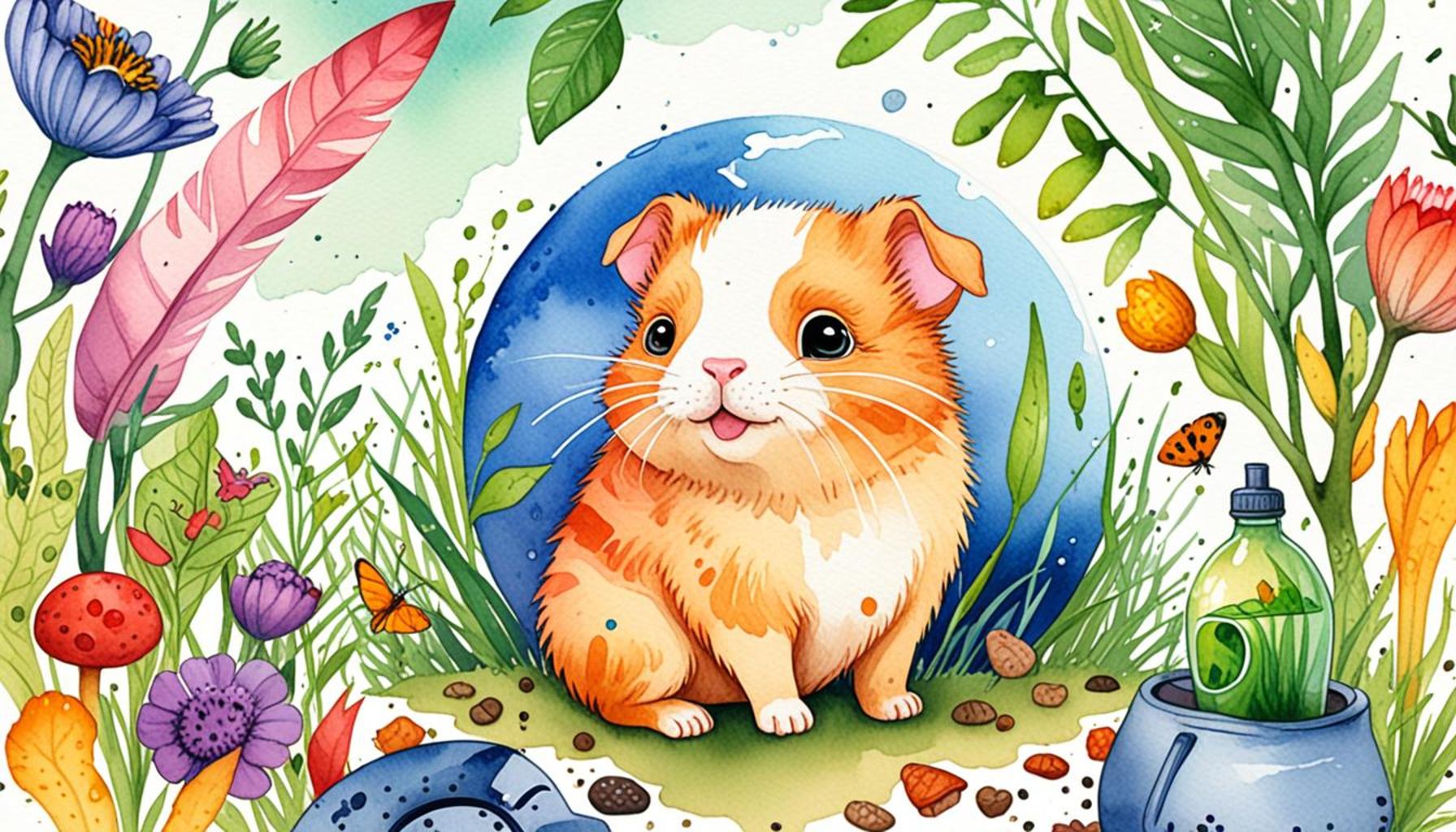The impact of environmental stress on the behavior of small pets

Understanding Environmental Stress in Small Pets
Small pets, such as hamsters, guinea pigs, and rabbits, were once seen as low-maintenance companions, but the reality is that they are profoundly affected by their surroundings. Environmental stress can lead to a domino effect of negative consequences impacting these animals’ behavior, health, and overall happiness. Therefore, recognizing and addressing these environmental stressors is essential for any responsible pet owner.
Common environmental stressors that can afflict small pets include:
- Excessive noise: Loud sounds, such as vacuum cleaners or loud conversations, can be overwhelming for small creatures with sensitive hearing.
- Temperature fluctuations: Rapid changes in temperature, whether from drafts or fluctuating indoor climates, can be dangerous and stressful.
- Lack of social interaction: Many small pets are social animals and thrive on interaction, be it with humans or their own kind.
- Inadequate space: A cramped living environment can lead to stress and even chronic health issues as pets don’t have enough room to roam.
- Poor diet: A balanced diet is crucial; a lack of nutrients can lead to anxiety and physical ailments.
When exposed to such stressors, pets may exhibit a range of behavioral changes. These reactions can manifest as:
- Aggressive behaviors: Actions like biting or scratching often stem from fear or discomfort.
- Withdrawal or lethargy: Pets may become less active, losing interest in play and interaction, which is detrimental to their mental health.
- Destructive tendencies: Chewing on cages or toys can be a way to relieve boredom or stress.
- Changes in eating habits: A stressed pet may eat less or overeat, both of which can lead to serious health issues.
Addressing environmental stress is crucial for a happy and healthy pet. Simple adjustments—like providing a quieter habitat, ensuring stable temperatures, or enhancing social interaction—can significantly improve their quality of life. Owners should also create a spacious living area filled with enrichment activities and ensure that dietary needs are met through fresh vegetables, hay, and specialized pellets.
Through understanding and acting on these factors, pet owners can foster a nurturing environment that keeps their small companions thriving. Investing time to learn about individual pet behaviors and preferences not only leads to happier pets but also builds stronger bonds between the animal and owner, paving the way for a longer, healthier life together.

DIVE DEEPER: Click here to learn about the benefits of positive reinforcement
The Physical and Psychological Effects of Environmental Stress
Environmental stress can profoundly affect small pets, manifesting in both physical and psychological ways. Just like humans, small animals experience stress due to their surroundings, leading to a variety of health concerns and behavioral issues. Understanding these impacts is critical for pet owners aiming to foster a healthy, happy environment for their furry companions.
Physical Repercussions of Stress
The body of a small pet responds to stress much like our own, releasing hormones such as cortisol that can create a wide range of physical symptoms. For instance, exposure to temperature fluctuations can result in hypothermia or heat stress, both of which are serious conditions that may compromise a pet’s health. According to veterinarians, hamsters and rabbits are especially susceptible when temperatures change dramatically, leading to a decrease in immune function and increased vulnerability to illness.
Other physical effects of stress include:
- Gastrointestinal disturbances: Just as humans experience stomachaches when stressed, pets can suffer from diarrhea or constipation, which can lead to further health risks.
- Weight fluctuations: Stressed pets may either overeat as a coping mechanism or lose their appetite, resulting in concerning weight changes that can affect their overall health.
- Skin problems: Stress can lead to excessive grooming or biting, resulting in skin irritation or infections.
The Behavioral Manifestations of Stress
Behaviorally, small pets exhibit a range of reactions when exposed to environmental stressors. For example, excessive noise can lead to heightened anxiety. A study conducted by the American Veterinary Medical Association highlighted that animals exposed to loud environments often display signs of distress, including hyperactivity and aggression.
Common behavioral issues arising from environmental stress include:
- Increased aggression: When feeling threatened or frightened, small pets may resort to biting or scratching as a defense mechanism.
- Lethargy and withdrawal: A stressed pet may retreat from social interaction and play, resulting in decreased quality of life.
- Destructive behavior: Chewing or digging can be an outlet for stress, but this behavior can also damage their habitat and toys.
Recognizing these symptoms is essential for pet owners to intervene effectively and ameliorate their pets’ environments. By monitoring behavioral changes, owners can detect the presence of stressors and take appropriate action to create a more stable atmosphere.
In conclusion, the impacts of environmental stress on small pets underline the importance of a well-managed living space. Acknowledging these challenges helps in creating an enriching environment that ensures the physical health and emotional well-being of furry companions. Thus, integrating environmental considerations into care practices is vital for an enhanced pet ownership experience.
The Impact of Environmental Stress on Small Pets
Environmental stress plays a crucial role in influencing the behavior of small pets, including rabbits, guinea pigs, and hamsters. Unlike larger pets, these smaller animals often have heightened sensitivity to changes in their environment, which can trigger stress responses that drastically alter their behavior. When exposed to stressors such as loud noises, extreme temperatures, or changes in routine, small pets may exhibit signs of anxiety, aggression, or withdrawal. For instance, a sudden loud sound from outside may cause a small pet like a rabbit to freeze in fear or bolt to a hidden corner. This reaction is not just a simple fright; it can lead to long-term effects on their social interactions and general well-being.In addition, changes in habitat, such as relocating their cage or introducing new items into their environment, can also lead to behavioral changes. Small pets may react by becoming territorial, fussing over their space, or even developing obsessive behaviors. It’s critical for pet owners to be aware of these aspects and understand how they can mitigate stress through gentle handling, adequate environmental enrichment, and maintaining a stable habitat.
- Providing a quiet area away from disturbances can help alleviate stress.
- Regularly interacting with your pet in a calm manner fosters trust and reduces anxiety.
Exploring how different habitats impact the behavior of small pets reveals the importance of environmental conditions. By tuning into the subtle signals these animals express, owners can create supportive environments that promote healthier behaviors and improved quality of life. Meanwhile, socialization is vital for small pets that thrive on companionship. Often, lack of interaction can increase stress levels, so providing them with companionship—whether through human interaction or compatible cohabitation with other small pets—can significantly mitigate their stress responses. In the following section, we will explore specific examples of how various environmental factors impact the behavior of small pets, revealing crucial insights for current and prospective pet owners.
LEARN MORE: Click here to discover helpful strategies
Environmental Stressors: Identifying Key Factors
Environmental stressors vary widely and can significantly influence the behavior and well-being of small pets. In understanding these factors, pet owners can mitigate risks and promote healthier living conditions. By recognizing the types of stressors that small pets might face, owners can create environments that are nurturing rather than detrimental.
Common Environmental Stressors
There are several common environmental stressors that can disturb the peace of small pets, rendering them anxious or fearful. Identifying these stressors is the first step toward minimizing their impact. Among the most prevalent are:
- Temperature Extremes: Both heat and cold can adversely affect small animals. For instance, gerbils thrive in moderate temperatures but can suffer heat stroke if exposed to high heat without adequate ventilation. Additionally, ferrets can become lethargic in excessively cold environments, leading to potential lethargy and decreased immune function.
- Inadequate Space: Overcrowding can lead to heightened competition for resources. For small pets such as rabbits and guinea pigs, limited space can result in territorial behavior or social aggression, resulting in fights among conspecifics.
- Noisy Environments: Loud or sudden noises can startle pets, making them feel threatened. A study indicated that pets exposed to consistent high decibel levels exhibited symptoms akin to PTSD, including avoidance behavior and increased aggression. Common noise sources include household appliances, loud music, or unexpected events like fireworks.
Social Interaction and Environmental Stress
The social dynamics of a pet’s environment also play a critical role in managing stress levels. Small pets often thrive on companionship; however, inconsistencies in social interaction can lead to anxiety. Pets such as hamsters, which are typically solitary, may feel stressed in close quarters with other animals, while social pets like ferrets may suffer significantly from isolation.
Monitoring how pets interact with their environment can reveal significant stressors. Common signs of social stress include:
- Increased Hiding: Pets may withdraw from view when overwhelmed, indicating a need for a quieter, safer space.
- Excessive vocalization: A stressed pet may become overly vocal, signaling distress, especially in small pets such as parakeets and rabbits.
- Reluctance to Engage: Disinterest in play or socializing can indicate significant stress levels; this is particularly evident in species like guinea pigs that normally exhibit playful behavior.
Understanding the nuances of how social interactions or lack thereof affect behavior is essential for fostering a supportive environment for small pets. Providing appropriate socialization opportunities, alongside quiet spaces for retreat, can ameliorate these stresses and enhance the pet’s quality of life.
Recognizing the environmental stressors that affect small pets can greatly inform care practices. By making necessary adjustments, pet owners not only promote a healthier lifestyle but also encourage a more fulfilling companionship with their animals.
DISCOVER MORE: Click here to learn how to find the perfect pet shelter
Conclusion: Enhancing Small Pets’ Well-Being Through Awareness
In conclusion, the impact of environmental stress on the behavior of small pets is a critical aspect of pet care that deserves the attention of all pet owners. As we have explored, factors such as temperature extremes, inadequate space, and noisy surroundings can profoundly affect the emotional and physical health of pets. Recognizing these stressors is not merely an academic exercise; it serves as a vital tool for enhancing the quality of life for these animals.
By fostering an environment that mitigates stress, owners can nurture well-adjusted pets who exhibit happier and more stable behaviors. For instance, maintaining appropriate temperature ranges, providing ample space for movement, and creating quieter areas for retreat can lead to noticeable improvements in a pet’s demeanor. Additionally, understanding the social needs of different species is crucial—whether that means providing companionship for social animals or ensuring solitude for those that prefer it.
Ultimately, a successful pet-care strategy should prioritize the mental and emotional health of small pets alongside their physical needs. As part of this commitment, owners are encouraged to continually educate themselves about the unique challenges that their pets face. Emphasizing the importance of a nurturing environment will not only foster a stronger bond between pets and their caregivers but also pave the way for a more fulfilling and happy life for these beloved companions. By remaining vigilant and responsive to their pets’ needs, owners can significantly reduce environmental stress and enjoy all the joy that small pets bring into their lives.


